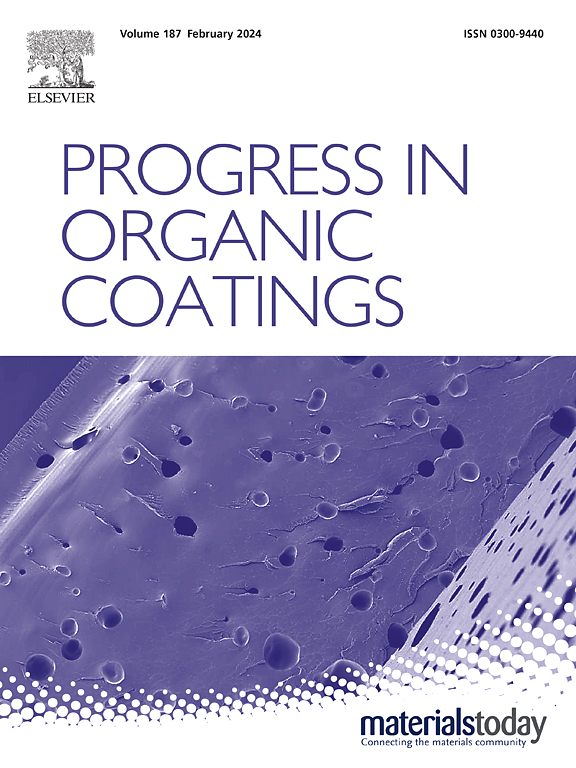受污染钢板在水性和溶剂型环氧涂料中的润湿性:表面张力和表面自由能组分之间的相互作用
IF 6.5
2区 材料科学
Q1 CHEMISTRY, APPLIED
引用次数: 0
摘要
本研究探讨了液态环氧涂料在清洁、油污和表面腐蚀的钢基体上的润湿性,强调了表面张力组分的作用及其与表面自由能的相互作用。使用了接触角和垂坠滴测量,以及基于模型的理想和粗糙度校正粘附工作估计。Owens, Wendt, Rabel和Kaelble (OWRK)方法结合酸碱理论,量化了表面张力和表面自由能的色散、极性和酸碱组分。结果表明,十种涂料的表面张力变化最小,水性配方的值略高于溶剂型。附着力的粗糙度校正工作,结合表面张力和界面张力,有效地解释了润湿性。与预期相反,由于极性添加剂(如二烷基二硫代磷酸锌)的存在,水性和溶剂型涂料在受发动机油污染的钢材上的润湿性都优于清洁基材。虽然OWRK理论的界面张力解释了非极性硅油污染和表面腐蚀钢的润湿性,但它对极性机油污染表面的效果较差。使用水(γ+ = γ−= 25.5)和甘油(γ+ = 3.92, γ−= 57.4)的标准参数,酸碱法的界面张力澄清了极性发动机油污染和腐蚀钢的润湿性。但不能解释非极性硅油污染钢的润湿性能。对这项工作的机理理解有助于提高涂层的润湿性和表面容忍度,特别是对油污染和表面腐蚀的钢表面。本文章由计算机程序翻译,如有差异,请以英文原文为准。
Wettability of contaminated steel panels by water- and solvent-borne epoxy coatings: Interactions among surface tension and surface free energy components
This study explores the wettability of liquid epoxy coatings on clean, oil contaminated, and surface-corroded steel substrates, emphasizing the role of surface tension components and their interaction with surface free energy. Contact angle and pendant drop measurements, along with model-based estimations of ideal and roughness-corrected work of adhesion, were utilized. The Owens, Wendt, Rabel, and Kaelble (OWRK) method, combined with acid-base theory, quantified the dispersive, polar, and acid-base components of surface tension and surface free energy.
Results showed minimal variations in surface tension among ten coatings, with waterborne formulations having slightly higher values than solvent-borne ones. The roughness-corrected work of adhesion, combined with surface tension and interfacial tension, effectively explained wettability. Contrary to expectations, both water- and solvent-borne coatings demonstrated better wettability on engine oil contaminated steels compared to clean substrates, due to polar additives like zinc dialkyl dithiophosphate. While the interfacial tension from the OWRK theory explained wettability on non-polar silicone oil contaminated and surface-corroded steels, it was less effective for polar engine oil contaminated surfaces. The interfacial tension from the acid-base approach, using standard parameters for water (γ+ = γ− = 25.5) and glycerol (γ+ = 3.92, γ− = 57.4), clarified wetting on polar engine oil contaminated and corroded steels. However, it could not explain the wetting performance on non-polar silicone oil contaminated steels.
The mechanistic understanding of this work helps to enhance coating wettability and surface tolerance, particularly for oil contaminated and surface-corroded steel surfaces.
求助全文
通过发布文献求助,成功后即可免费获取论文全文。
去求助
来源期刊

Progress in Organic Coatings
工程技术-材料科学:膜
CiteScore
11.40
自引率
15.20%
发文量
577
审稿时长
48 days
期刊介绍:
The aim of this international journal is to analyse and publicise the progress and current state of knowledge in the field of organic coatings and related materials. The Editors and the Editorial Board members will solicit both review and research papers from academic and industrial scientists who are actively engaged in research and development or, in the case of review papers, have extensive experience in the subject to be reviewed. Unsolicited manuscripts will be accepted if they meet the journal''s requirements. The journal publishes papers dealing with such subjects as:
• Chemical, physical and technological properties of organic coatings and related materials
• Problems and methods of preparation, manufacture and application of these materials
• Performance, testing and analysis.
 求助内容:
求助内容: 应助结果提醒方式:
应助结果提醒方式:


